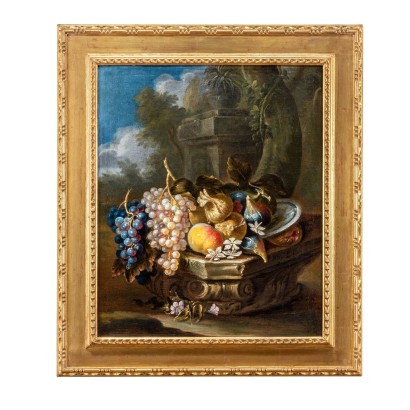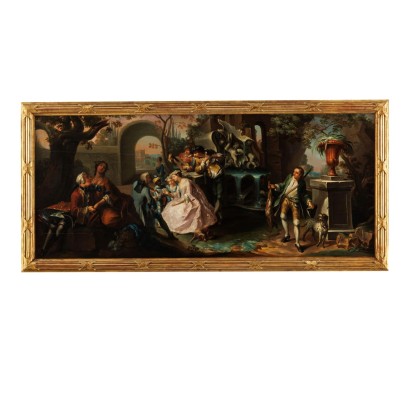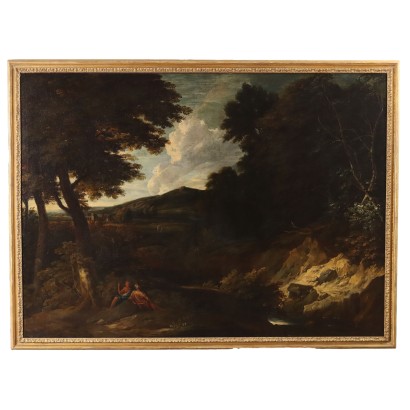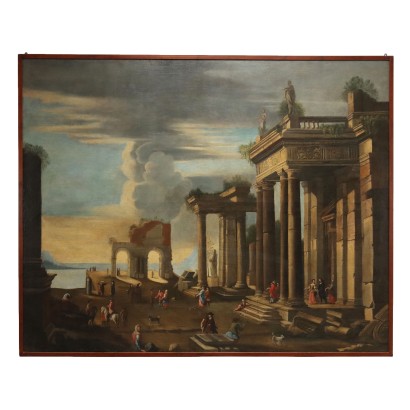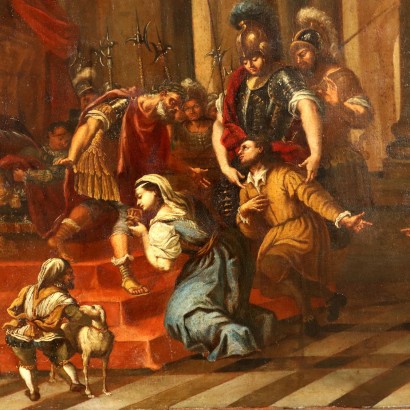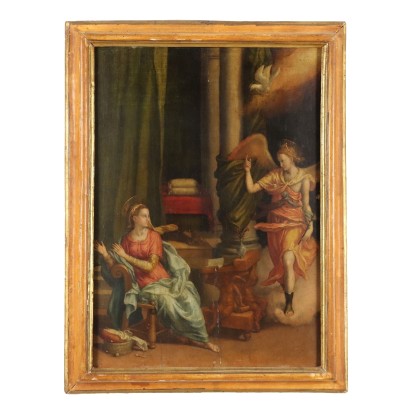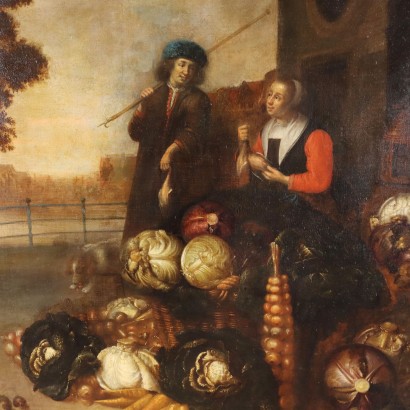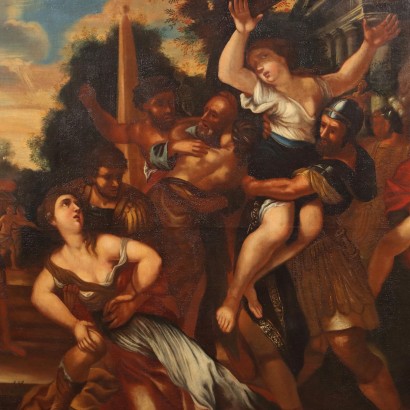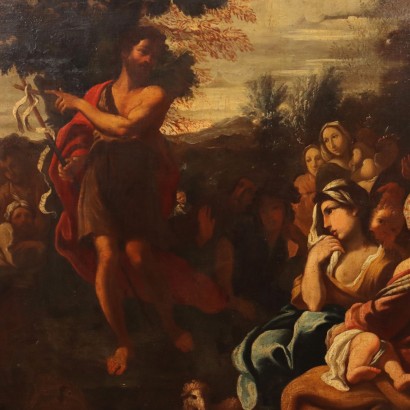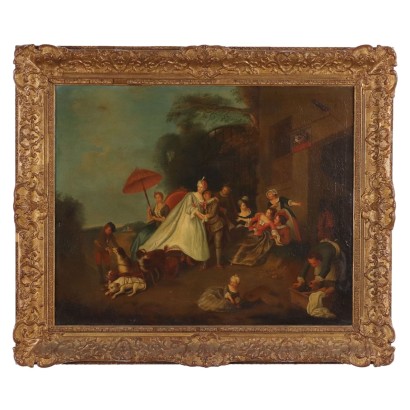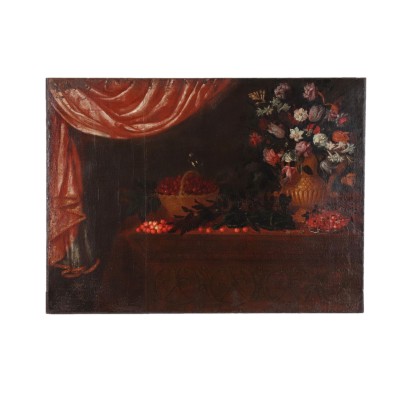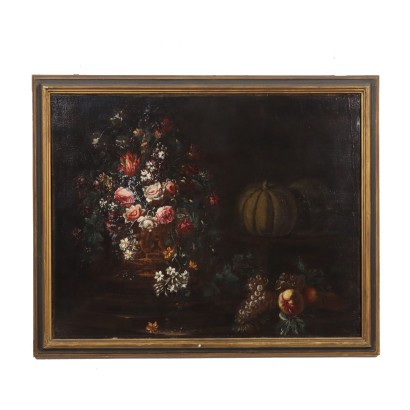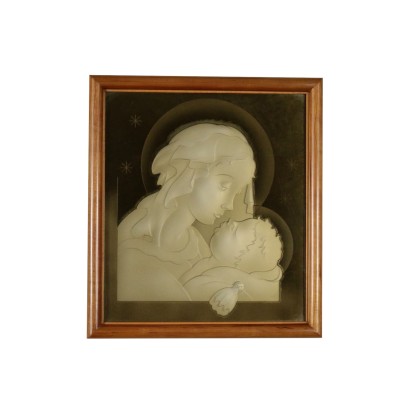Antique Painting Signed Maximilian Pfeiler Oil on Canvas XVII Century - Grapes, figs, pomegranates and peaches on a capital
Features
Grapes, figs, pomegranates and peaches on a capital
Artist: Maximilian Pfeiler (1656-1746)
Artwork title: Natura morta con Uva, Fichi, Melagrana e Pesche
Subject: Still life
Artistic technique: Painting
Technical specification: Oil on Canvas
Description : Natura morta con Uva, Fichi, Melagrana e Pesche
Oil on canvas. Signed ‘Max. PF.' on the upper frame of the capital. The still life consists of grapes, pomegranate and peaches placed on a capital, there is also a silver tray in the composition; in the background is a landscape with trees and ruins, on the left is a glimpse of a cerulean sky, barely veiled by clouds. Maximilian Pfeiler made a name for himself with his still lifes in which he placed an architectural fragment in the background of the flowers and fruit, already introducing the taste for ancient ruins that was to become fully established in the 18th century. The painting has been retouched and restored (minor repainting). It is presented in a frame.
Product Condition:
Product in good condition, with small signs of wear.
Frame Size (cm):
Height: 94
Width: 82
Depth: 5
Artwork dimensions (cm):
Height: 73
Width: 60,5
Additional Information
Notes historical bibliographic
Maximilian Pfeiler is a German artist, documented in Rome from 1694 to 1721; in the Capitoline city he was a pupil and follower of Christian Berentz. He specialized in the creation of still lifes, refined visually balanced compositions, consisting of fruit and metal plates in the typically late Baroque fashion. The rendering of light, certainly a derivation of the art of Northern Europe, is enhanced by the representation of his compositions en plein air. This characteristic is frequently found in his pictorial corpus, influenced by the example of Franz Werner Tamm, very significant in the location of the elements outside. Our painting, documented by Bocchi in his publication, is characterized by a more earthy palette used to make the second floor, which contrasts with the brighter one used for the still life. The fruit is represented with a typically Nordic lenticular attention, as well as the luministic rendering. The fruits in the foreground take on particular importance, thanks to the quick white brushstrokes used as points of light, which bring out the roundness of the grapes and figs.Artist: Maximilian Pfeiler (1656-1746)
The life of Maximilian Pfeiler, born in Prague around 1656, is not well documented and there are few chronological references regarding his activity. The few existing sources indicate that in 1683 he was a member of the Painters' Guild of Prague, his hometown, and a pupil of Christian Berentz (1658-1722), a painter of German origins who first traveled to the Netherlands and then settled in Rome, introducing Northern European themes of the still life genre in which he specialized to Italy. It is not clear whether Pfeiler's apprenticeship with Berentz already took place in Rome, where the Czech artist was certainly active from 1694, collaborating with Francesco Trevisani and Michele Rocca. Pfeiler thus managed to carve out a leading role for himself in the Roman art scene of the late 17th and early 18th centuries, creating extravagant and recognisable compositions of fruit and flowers that were much appreciated by illustrious men: for example, some of his works were part of Cardinal Fesch's collection.Subject: Still life
Artistic technique: Painting
La pittura è l'arte che consiste nell'applicare dei pigmenti a un supporto come la carta, la tela, la seta, la ceramica, il legno, il vetro o un muro. Essendo i pigmenti essenzialmente solidi, è necessario utilizzare un legante, che li porti a uno stadio liquido, più fluido o più denso, e un collante, che permetta l'adesione duratura al supporto. Chi dipinge è detto pittore o pittrice. Il risultato è un'immagine che, a seconda delle intenzioni dell'autore, esprime la sua percezione del mondo o una libera associazione di forme o un qualsiasi altro significato, a seconda della sua creatività, del suo gusto estetico e di quello della società di cui fa parte.Technical specification: Oil on Canvas
The oil painting is a painting technique using powder pigments mixed with bases in inert and oils.Other customers have searched:
Pittura antica, artisti italiani, pittura olio su tela, arte 800, pittura antica, arte novecento, oggetti d'arte, ritratto di signora, dipinto animali, quadro paesaggio montano, dipinto olio su tela, dipinto antico, dipinti natura morta, quadro antico, quadro del '600, pittori italiani quadri olio su tela paesaggi, paesaggio marino dipinto, paesaggio invernale dipinto, paesaggio autunnale dipinto, dipinto di paesaggio, arte antica, quadro religioso..
Se sei un appassionato d'arte, non perderti i nostri approfondimenti sul Blog Arte Di Mano in Mano e su FineArt by Di Mano in Mano - Arte:
Leggi di più
Ecco alcuni tra i principali articoli:
Vedute
Falsi nell'arte antica
Un messaggio di fiducia per ripartire
La potenza espressiva dell'arte figurativa etiope
Breve Storia del Collezionismo
Giorgio Upiglio, maestro dei libri d'artista
Matthias Withoos detto "Calzetta bianca"
San Rocco pensaci tu - Classic Monday
Dai un'occhiata alle nostre rubriche di divulgazione sull'arte:
Epoche
Lavorazioni e tecniche
Mostre ed Eventi
Protagonisti
Se sei appassionato di pittura antica, con tutta probabilità gusterai le schede di questi stupendi quadri:
"Dio parla a Noè dopo il diluvio", Jacopo da Ponte, detto il Bassano, seconda metà XVI secolo
Crocifissione, maestro della misericordia dell'accademia, terzo quarto del XIV secolo
Erminia incontra i pastori, Camillo Gavassetti, Seconda metà anni Venti del XVII Secolo
Eroine dell'antichità, Francesco Conti, XVIII secolo
Hieronymus III Francken, La Negazione di Pietro, XVII secolo
Jefte e la figlia, Girolamo Forabosco e aiuti, XVII secolo
L'Accademia di Platone, piccolo arazzo, fine XVII - inizio XVIII secolo
Maddalena e San Giovanni Battista
Natura Morta, Bartolomeo Arbotori, XVIII secolo
Sacra Famiglia con San Giovannino, Bartolomeo Ramenghi, scuola di, prima metà XVI secolo
Testa Femminile, Andrea del Sarto, ambito di, post 1522
Uva, fichi, melagrana e pesche su un capitello - Maximilian Pfeiler, primo quarto XVIII secolo
Sapevi che l'arte può essere anche un ottimo investimento (e non solo per grandi portafogli)?
L'Arte tra Collezionismo e Investimento
FineArt: Arte come investimento
Leggi di più
Ecco alcuni tra i principali articoli:Vedute
Falsi nell'arte antica
Un messaggio di fiducia per ripartire
La potenza espressiva dell'arte figurativa etiope
Breve Storia del Collezionismo
Giorgio Upiglio, maestro dei libri d'artista
Matthias Withoos detto "Calzetta bianca"
San Rocco pensaci tu - Classic Monday
Dai un'occhiata alle nostre rubriche di divulgazione sull'arte:
Epoche
Lavorazioni e tecniche
Mostre ed Eventi
Protagonisti
Se sei appassionato di pittura antica, con tutta probabilità gusterai le schede di questi stupendi quadri:
"Dio parla a Noè dopo il diluvio", Jacopo da Ponte, detto il Bassano, seconda metà XVI secolo
Crocifissione, maestro della misericordia dell'accademia, terzo quarto del XIV secolo
Erminia incontra i pastori, Camillo Gavassetti, Seconda metà anni Venti del XVII Secolo
Eroine dell'antichità, Francesco Conti, XVIII secolo
Hieronymus III Francken, La Negazione di Pietro, XVII secolo
Jefte e la figlia, Girolamo Forabosco e aiuti, XVII secolo
L'Accademia di Platone, piccolo arazzo, fine XVII - inizio XVIII secolo
Maddalena e San Giovanni Battista
Natura Morta, Bartolomeo Arbotori, XVIII secolo
Sacra Famiglia con San Giovannino, Bartolomeo Ramenghi, scuola di, prima metà XVI secolo
Testa Femminile, Andrea del Sarto, ambito di, post 1522
Uva, fichi, melagrana e pesche su un capitello - Maximilian Pfeiler, primo quarto XVIII secolo
Sapevi che l'arte può essere anche un ottimo investimento (e non solo per grandi portafogli)?
L'Arte tra Collezionismo e Investimento
FineArt: Arte come investimento
Product availability
Immediate availability
Ready for delivery within 2 working days from ordering the product.



